Scientists have proven that there are asteroids that are resistant to external influences. This means that the tested methods are not suitable for protecting the Earth from such objects. Scientists have discovered possible “seeds of life” in the matter of asteroids: The idea that life originated outside our solar system has been around for a very long time, and now analysis of new asteroid samples is providing evidence for this “panspermia” theory.
Asteroid Itokawa
In 2022, during the DART mission, a special kamikaze vehicle, for experimental purposes, crashed into the Dimorph asteroid, harmless to the Earth, changing its orbit. However, judging by new data, this may not work with other celestial bodies potentially dangerous to humanity. For example, with the Itokawa asteroid. Images taken by a Japanese spacecraft back in 2010 demonstrated that asteroids are sometimes not a solid rock, but a collection of debris.
Recently, an international team of scientists led by Fred Jourdan from Australia’s Curtin University studied three dust particles taken from the surface of Itokawa and brought to Earth by the Hayabusa-1 probe. The composition of the tiny regolith grains was studied using so-called secondary ion mass spectrometry. It turned out that the 535-meter asteroid, whose intricate orbit crosses that of Earth and Mars, is extremely resistant to collisions.
Scientists estimate that approximately 40 percent of the volume of the celestial body is void. This means that the cosmic “pile of rubble,” as the researchers themselves call the object in a press release, has strong shock-absorbing properties: instead of collapsing, individual stones will be pressed inward. “In short, Itokawa is like a giant space cushion that is very difficult to destroy,” says Professor Jourdan. According to the authors of the work, the kinetic energy that a small spacecraft can impart to such an asteroid is too small. Therefore, with sites like Itokawa, the DART mission may fail.
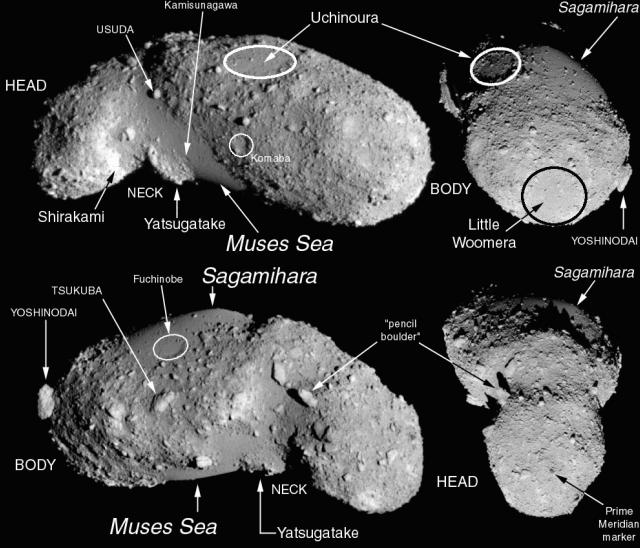
Asteroid Itokawa
The stability of the debris asteroid is confirmed by its age, which Jourdan’s team estimated at 4.2 billion years. That is, the object is almost as old as the Solar System itself (4.57). This is surprising, because, according to calculations, monolithic structures of the same size live an order of magnitude shorter – no more than several hundred million years. Such an impressive survival rate indicates that there should be many objects similar to Itokawa in the solar system, the authors of the article believe. This means that there is a high probability that the Earth will be threatened by one of them.
The Earth is constantly bombarded by various cosmic bodies. However, according to scientists from Oxford, the chances of human extinction due to a meteorite fall do not exceed a hundredth of a percent. Earthly tracking devices clearly see all objects large enough to wipe out our species from the face of the planet. The Chicxulub asteroid, which is believed to have killed the dinosaurs, had a diameter of about ten kilometers. But nothing like this will come to us in the foreseeable future.
A hypothetical impact from smaller celestial rocks is not capable of leading to the extinction of humanity, but could result in numerous casualties and cause serious damage to the economy. Thus, the famous Tunguska meteorite, according to modern estimates, was only 75 meters in diameter. When it exploded, the diameter of the affected area in the taiga was almost 12 kilometers. This means that, under less fortunate circumstances, a small town could disappear.
Modern observatories are not always able to detect celestial bodies of this size in time. For example, a threat may approach from the Sun, which “blinds” telescopes. NASA estimates that there are approximately 17,000 near-Earth asteroids measuring 150 meters or larger that have yet to be found.
The timing of detection of the danger is a decisive factor. The sooner people see the object, the greater the chance of eliminating it. Speed is another weak point for missions like DART. For such an operation, you need to know in advance the orbit of the “cobblestone” flying towards us. A space ram cannot be organized if we see an asteroid or comet, for example, several months before the collision.
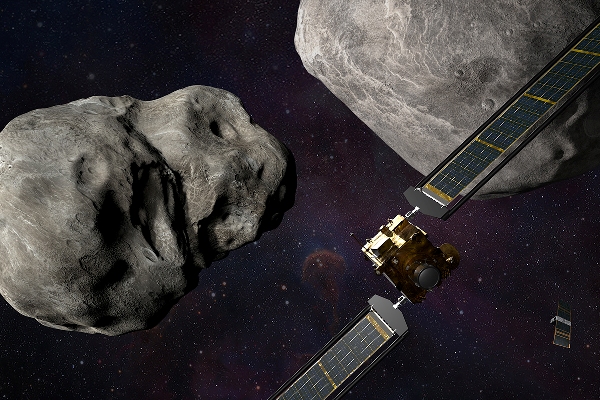
DART device. Illustration
In such cases, a scenario familiar from the movie “Armageddon” comes to the rescue – a nuclear explosion. “The last resort,” as experts call it. But no one is going to send a brutal oil driller like Bruce Willis into space. Delivery of a nuclear charge to the target will be automatic. One concept involves creating a spacecraft from two sections: the first separates earlier and creates a crater in the asteroid, and the second, carrying a charge, explodes there.
According to the calculations of American scientists, the destruction of a hundred-meter celestial object by a megaton atomic bomb even two months before the collision will lead to the fact that the vast majority of the debris will pass the Earth or burn up in the atmosphere. True, the authors of the article admit, only if the charge is placed correctly and the energy is calculated correctly. Otherwise, the debris will be too large and cause serious damage to the Earth. However, in this work we considered the situation with a monolithic celestial body.
For protection against a “space rubble pile” like Itokawa, an explosion on or under the asteroid’s surface is not the best choice. There is a risk that the debris will behave unpredictably. Jourdan and colleagues propose an alternative option – to detonate a nuclear bomb in front of a dangerous object. And then a powerful wave will, as it were, “push the asteroid away from the Earth without destroying its integrity.
True, unlike the space ram, this is still a pure theory. The authors of the new article are not sure that humanity needs practical tests of nuclear weapons in space. Moreover, this is prohibited by international agreements.
Asteroid Dimorphos
In September 2022, NASA’s DART mission crashed into the Dimorphos asteroid at 14,000 mph to test the effects of asteroid deflection. Although the mission was a success, scientists have since been analyzing the consequences of this first-ever man-made celestial redirection. This kinetic impact was part of the Double Asteroid Redirection Test (DART) mission, which was our species’ first attempt to intentionally redirect an object in space. Although the mission was considered a complete success, the aftermath of this celestial collision led to some unforeseen consequences.
In a new paper published in the journal Monthly Notices of the Royal Astronomical Society in mid-February, Marco Fennucci—a researcher at the European Space Agency’s (ESA) Near-Earth Object Coordination Center (NEOCC)—concluded that although the resulting debris The impact will not cause DART to burn up in the Earth’s atmosphere; some are heading towards the orbit of Mars, where a potential collision would have a completely different outcome. “They may have a chance to collide with Mars in the future,” the paper says. “Given the thinness of the Martian atmosphere, we expect the boulders to arrive on the Martian soil intact and form a small impact crater.”

Asteroid Dimorphos
Speaking to National Geographic, Fenucci noted that impact craters can be up to 1,000 feet wide. But because of its thin atmosphere, Mars is hit by space debris 3.2 times more often than the Moon. This is evidenced by Mars’ largest impact crater, the Hellas Basin, which is about twice the size of Alaska.
While estimates tens of millennia into the future may be a bit fuzzy, these new cosmic boulders won’t pass close to Mars until about 6,000 years in the future, and then again 13,000 years later.
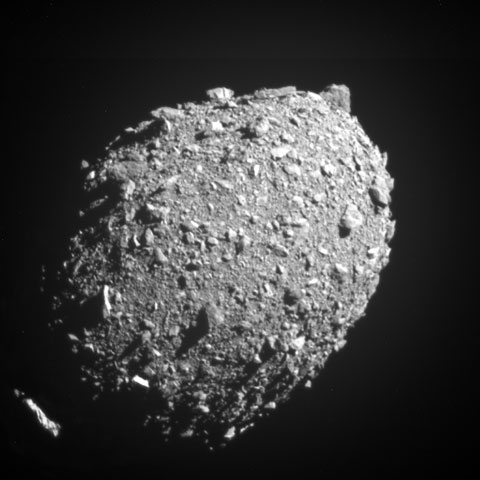
Asteroid Dimorphos
So while the DART mission could have an impact on the Red Planet in the distant future, a more immediate concern is ESA’s upcoming Hera mission to study the effects of DART in more detail. Launching this October and reaching the Didymos-Dimorphos system in December 2026, Hera will likely encounter about 37 new boulders floating around the twin asteroids in a debris field.
Asteroids Ryugu and Bennu
In a new study, scientists from Tohoku University confirm that asteroids like Ryugu, visited by JAXA’s Hayabusa2 spacecraft, carried cometary organic matter into the near-Earth region. This confirmation, along with other markers of life found on Ryugu (and on Bennu, which NASA’s OSIRIS-REx mission visited), provides compelling evidence that meteorites and asteroids may have delivered the substances necessary for life into Earth’s primordial mud billions of years ago.
The Japanese space agency JAXA launched its next mission, Hayabusa 2, from the asteroid Ryugu. In 2020, JAXA recovered 5.4 grams of material. This small but powerful specimen has already become a treasure trove of cosmic information. In 2022, scientists confirmed that the asteroid contains amino acids, which are literally the building blocks of life, as well as the nitrogenous base uracil, which helps form RNA.
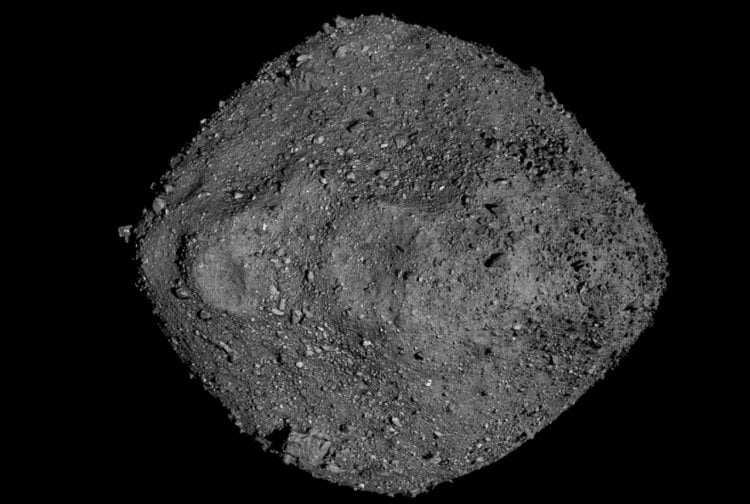
Asteroid Ryugu
Now, a new study by scientists from Tohoku University can confirm that Ryugu’s reserves provide sufficient evidence of “transfer of cometary organic matter from space to the near-Earth region,” according to a press release. Details of this discovery were published in the journal Science Advances.
Since Ryugu has no atmosphere, its surface layer is exposed to the destructive effects of space – mainly micrometeoroids of comet dust. Lead author Megumi Matsumoto and her team discovered incredibly small “melt splatters”, measuring just 5 to 20 micrometers across. This spray was created when micrometeoroids struck Ryugu’s exposed surface.
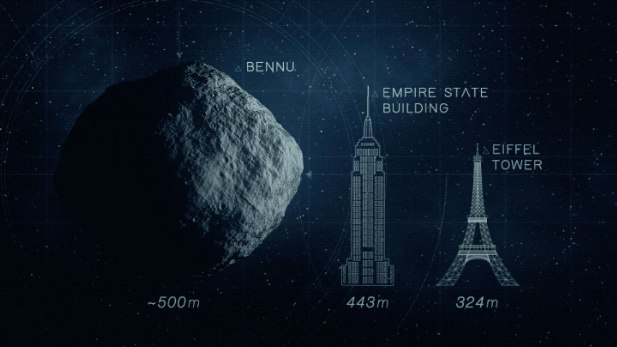
Asteroid Bennu
“Our 3D CT images and chemical analysis showed that the melt spatter consists primarily of silicate glasses with voids and small inclusions of spherical iron sulfides,” Matsumoto said in a press statement. “The chemistry of the melt spatter suggests that Ryugu hydrous silicates were mixed with comet dust.”
A closer look at these “melt splashes” revealed carbonaceous material similar to primitive organic matter. However, since it is not associated with nitrogen or oxygen, it is just a component of organic matter and not entirely organic matter. “We propose that the carbonaceous materials formed from cometary organic matter by evaporation of volatiles such as nitrogen and oxygen during impact-induced heating. This suggests that cometary material was transported to the near-Earth region from the outer solar system,” Matsumoto added. “This organic matter may be small seeds of life once brought from space to Earth.”
Interesting fact: the secret of Tutankhamun’s “space dagger”
Archaeologists have determined that the dagger from the tomb of Pharaoh Tutankhamun was forged from meteorite iron outside of Ancient Egypt, writes The Sun. This discovery confirmed the version that the dagger, discovered in Tutankhamun’s tomb in 1922, was originally sent as a gift to Tutankhamun’s grandfather from another ancient state. The artifact dates back to the 14th century BC, it was found near the thigh of the mummy of Tutankhamun. Past research has established that the blade is made of meteorite iron, which the ancient Egyptians did not know how to work with at that point in time.
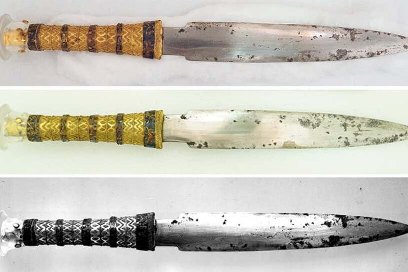
Analysis by a team of scientists from the Chiba Institute of Technology in Japan found that the object was smelted at less than 950 degrees Celsius and was likely manufactured outside Egypt in Anatolia. The X-ray study also demonstrated that the dagger’s gold hilt was made using lime plaster, which was used much later by the Egyptians. According to scientists, the young pharaoh inherited the dagger from his grandfather, as it was passed down from generation to generation.
Tutankhamun, pharaoh of the 18th Egyptian dynasty, ruled Egypt from 1332 to 1323 BC.




